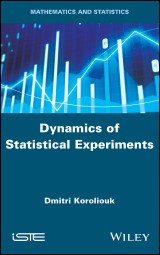Details
Dynamics of Statistical Experiments
1. Aufl.
|
139,99 € |
|
| Verlag: | Wiley |
| Format: | EPUB |
| Veröffentl.: | 14.04.2020 |
| ISBN/EAN: | 9781119720454 |
| Sprache: | englisch |
| Anzahl Seiten: | 224 |
DRM-geschütztes eBook, Sie benötigen z.B. Adobe Digital Editions und eine Adobe ID zum Lesen.
Beschreibungen
This book is devoted to the system analysis of statistical experiments, determined by the averaged sums of sampling random variables. The dynamics of statistical experiments are given by difference stochastic equations with a speci?ed regression function of increments – linear or nonlinear. The statistical experiments are studied by the sample volume increasing (N ??), as well as in discrete-continuous time by the number of stages increasing (k ??) for different conditions imposed on the regression function of increments. The proofs of limit theorems employ modern methods for the operator and martingale characterization of Markov processes, including singular perturbation methods. Furthermore, they justify the representation of a stationary Gaussian statistical experiment with the Markov property, as a stochastic difference equation solution, applying the theorem of normal correlation. The statistical hypotheses verification problem is formulated in the classification of evolutionary processes, which determine the dynamics of the predictable component. The method of stochastic approximation is used for classifying statistical experiments.
<p>Preface ix</p> <p>List of Abbreviations xi</p> <p>Introduction xiii</p> <p><b>Chapter 1 Statistical Experiments 1</b></p> <p>1.1 Statistical experiments with linear regression 1</p> <p>1.1.1 Basic definitions 1</p> <p>1.1.2 Difference evolution equations 3</p> <p>1.1.3 The equilibrium state 4</p> <p>1.1.4 Stochastic difference equations 7</p> <p>1.1.5 Convergence to the equilibrium state 9</p> <p>1.1.6 Normal approximation of the stochastic component 11</p> <p>1.2 Binary SEs with nonlinear regression 13</p> <p>1.2.1 Basic assumptions 13</p> <p>1.2.2 Equilibrium 15</p> <p>1.2.3 Stochastic difference equations 17</p> <p>1.2.4 Convergence to the equilibrium state 18</p> <p>1.2.5 Normal approximation of the stochastic component 20</p> <p>1.3 Multivariate statistical experiments 22</p> <p>1.3.1 Regression function of increments 22</p> <p>1.3.2 The equilibrium state of multivariate EPs 25</p> <p>1.3.3 Stochastic difference equations 26</p> <p>1.3.4 Convergence to the equilibrium state 28</p> <p>1.3.5 Normal approximation of the stochastic component 29</p> <p>1.4 SEs with Wright–Fisher normalization 31</p> <p>1.4.1 Binary RFs 31</p> <p>1.4.2 Multivariate RFIs 33</p> <p>1.5 Exponential statistical experiments 35</p> <p>1.5.1 Binary ESEs 36</p> <p>1.5.2 Steady regime of ESEs 37</p> <p>1.5.3 Approximation of ESEs by geometric Brownian motion 38</p> <p><b>Chapter 2 Diffusion Approximation of Statistical Experiments in Discrete–Continuous Time 43</b></p> <p>2.1 Binary DMPs 44</p> <p>2.1.1 DMPs in discrete–continuous time 45</p> <p>2.1.2 Justification of diffusion approximation 47</p> <p>2.2 Multivariate DMPs in discrete–continuous time 51</p> <p>2.2.1 Evolutionary DMPs in discrete–continuous time 52</p> <p>2.2.2 SDEs for the DMP in discrete–continuous time 53</p> <p>2.2.3 Diffusion approximation of DMPs in discrete–continuous time 55</p> <p>2.3 A DMP in an MRE 58</p> <p>2.3.1 Discrete and continuous MRE 58</p> <p>2.3.2 Proof of limit theorems 2.3.1 and 2.3.2 62</p> <p>2.4 The DMPs in a balanced MRE 65</p> <p>2.4.1 Basic assumptions 66</p> <p>2.4.2 Proof of limit theorem 2.4.1 70</p> <p>2.5 Adapted SEs 74</p> <p>2.5.1 Bernoulli approximation of the SE stochastic component 75</p> <p>2.5.2 Adapted SEs 77</p> <p>2.5.3 Adapted SEs in a series scheme 79</p> <p>2.6 DMPs in an asymptotical diffusion environment 84</p> <p>2.6.1 Asymptotic diffusion perturbation 85</p> <p>2.7 A DMP with ASD 91</p> <p>2.7.1 Asymptotically small diffusion 91</p> <p>2.7.2 EGs of DMP 94</p> <p>2.7.3 AF of DMPs 97</p> <p><b>Chapter 3 Statistics of Statistical Experiments 103</b></p> <p>3.1 Parameter estimation of one-dimensional stationary SEs 103</p> <p>3.1.1 Stationarity 103</p> <p>3.1.2 Covariance statistics 108</p> <p>3.1.3 <i>A priori </i>statistics 110</p> <p>3.1.4 Optimal estimating function 111</p> <p>3.1.5 Stationary Gaussian SEs 114</p> <p>3.2 Parameter estimators for multivariate stationary SEs 115</p> <p>3.2.1 Vector difference SDEs and stationarity conditions 116</p> <p>3.2.2 Optimal estimating function 118</p> <p>3.2.3 Stationary Gaussian Markov SEs 119</p> <p>3.3 Estimates of continuous process parameters 122</p> <p>3.3.1 Diffusion-type processes 122</p> <p>3.3.2 Estimation of a continuous parameter 123</p> <p>3.4 Classification of EPs 124</p> <p>3.4.1 Basic assumption 125</p> <p>3.4.2 Classification of EPs 126</p> <p>3.4.3 Justification of EP models classification 127</p> <p>3.4.4 Proof of Theorem 3.4.1 129</p> <p>3.4.5 Interpretation of EPs 133</p> <p>3.4.6 Interpretation of EPs in models of collective behavior 138</p> <p>3.5 Classification of SEs 139</p> <p>3.5.1 The SA of SEs 139</p> <p>3.5.2 Classifiers 140</p> <p>3.5.3 Classification of SEs 142</p> <p>3.6 Evolutionary model of ternary SEs 144</p> <p>3.6.1 Basic assumptions 144</p> <p>3.6.2 The model interpretation and analysis 146</p> <p>3.7 Equilibrium states in the dynamics of ternary SEs 149</p> <p>3.7.1 Building a model 149</p> <p>3.7.2 The equilibrium state and fluctuations 150</p> <p>3.7.3 Classification of TSEs 151</p> <p><b>Chapter 4 Modeling and Numerical Analysis of Statistical Experiments 153</b></p> <p>4.1 Numerical verification of generic model 153</p> <p>4.1.1 Evolutionary processes with linear and nonlinear RFIs 153</p> <p>4.1.2 Generic model of trajectory generation 156</p> <p>4.2 Numerical verification of DMD 158</p> <p>4.2.1 Simulation of DMD trajectories 158</p> <p>4.2.2 Estimation of DMD parameters 163</p> <p>4.3 DMD and modeling of the dynamics of macromolecules in biophysics 167</p> <p>4.3.1 The model motivation 168</p> <p>4.3.2 Statistical model of a stationary DMD 169</p> <p>4.3.3 Stokes–Einstein kinetic diffusion model 171</p> <p>4.3.4 Verification of the model of stationary DMD by direct numerical simulation 172</p> <p>4.3.5 Numerical verification of DMD characteristics using the model of Stokes–Einstein 173</p> <p>4.3.6 The ability of the DMD model to detect the proportion of fast and slow particles 176</p> <p>4.3.7 Interpretation of the mixes of Brownian motions 182</p> <p>References 189</p> <p>Index 193</p>
<p><b>Dmitri Koroliouk</b> is a Doctor of Sciences (Hab.), leading researcher at the Institute of Telecommunications and Global Information Space of the National Academy of Sciences of Ukraine, and Professor at the National Technical University of Ukraine "Igor Sikorsky Kyiv Polytechnic Institute". He is the author of 80 scientific publications and also holds 10 European patents for industrial invention.</p>
Diese Produkte könnten Sie auch interessieren:

Nonparametric Regression Methods for Longitudinal Data Analysis

von: Hulin Wu, Jin-Ting Zhang

135,99 €

Statistics and the Evaluation of Evidence for Forensic Scientists

von: Colin Aitken, Franco Taroni

103,99 €















